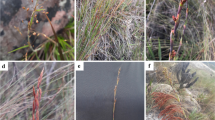Summary
-
1.
InTradescantia virginiana var.humilis the following observations were made on meiosis:
-
(i)
arrest of terminalisation of chiasmata
-
(ii)
pairing of unequal chromosomes
-
(iii)
torsion of chromatids
-
(iv)
morphological change in chromosome
-
(v)
pairing of fragments, discussed in relation to the chiasma theory of metaphase pairing.
-
2.
InRhoeo discolor pachytene, diplotene and diakinesis stages were observed. The metaphase end-to-end pairing of the chromosomes was observed to follow earlier side-by-side pairing of homologous ends.
The observations show that both species obey the general principles of meiosis as recently outlined by Darlington.
Similar content being viewed by others
References
Beadle, G. W. (1932). “A possible influence of the spindle fibre on crossing-over inDrosophila.”Proc. Nat. Acad. Sci.18, 160–5.
Belling, J. (1925). “The origin of chromosomal mutation inUvularia.”Journ. Gen.15, 245–66.
— (1927).“The attachment of chromosomes at the reduction division in flowering plants.”Ibid. 18, 177–205.
Belling, J. andBlakeslee, A. F. (1926). “On the attachment of non-homologous chromosomes at the reduction division in certain 25-chromosomeDaturas.”Proc. Nat. Acad. Sci.12, 7–11.
Bebgner, D. andBlakeslee, A. F. (1932). “Cytology of theFerox-Quercifolia-Stramonium triangle inDatura.”Ibid.18, 151–60.
Bridges, C. B. andAnderson, E. G. (1925).“Crossing-over in the X-chromosome of triploid females ofDrosophila melanogaster.”Genetics,10, 418–41.
Burnham, C. R. (1930). “Genetical and cytological studies of semi-sterility and related phenomena in maize.”Proc. Nat. Acad. Sci.16, 267–74.
Cleland, R. E. andBlakeslee, A. F. (1931). “Segmental interchange, the basis of chromosomal attachments inOenothera.”Cylologia,2, 175–233.
Cooper, D. E. andBrink, R. A. (1931). “Cytological evidence for segmental interchanges between non-homologous chromosomes in maize.”Proc. Nat. Acad. Sci.17, 334–8.
Dablington, C. D. (1929). “Chrornosorne behaviour and structural hybridity in theTradescantiae.”Journ. Gen.21, 207–86.
— (1930). “Chromosome studies inFritillaria. III.”Cytologia,2, 37–55.
— (1931a). “Meiosis in diploid and tetraploidPrimula sinensis.”Journ. Gen. 14, 65–96.
— (1931b). “Meiosis.”Biol. Rev. 6, 1–43.
— (1931c). “The cytological theory of inheritance inOenolhera.”Journ. Gen. 24, 405–75.
— (1932).Recent advances in cytology. Churchill, London (in press).
Dablington, C. D. andDabk, S. O. S. (1032). “Origin and behaviour of chiasmata. II.Stenobothrus parallelus.”Cytologia,4 (in press).
Dobzhansky, T. (1931). “The decrease of crossing-over observed in translocations, and its probable explanation.”Amer. Nat.65, 214–32.
Erlanson, E. W. (1931). “Chromosome organisation inRosa.”Cytologia,2, 256–82.
Frost, H. B. (1927). “Chromosome-mutant types in stocks (MaUhiola incana). I. Characters due to extra chromosomes.”Journ. Heredity,18, 475–86.
Gairdner, A. E. andDarlington, C. D. (1931). “Ring formation in diploid and polyploidCampanula persicifolia.”Genelica,13, 113–50.
Gates, R. (1908). “A study of reduction inOenothera rubrinervis.”Bot. Gazelle,46, 1–34.
— (1928). “The cytology ofOenothera.”Bibl. Genetica,4, 401–92.
Håkansson, A. (1931). “Ueber Chromosomenverkettung inPisum.”Hereditas,15 2–61.
Hoar, C. S. (1931). “Meiosis inHypericum punctatum Lam.”Bot. Gaz.92, 396–406.
Kato, K. (1930). “Cytological studies of pollen mother cells ofRhoeo discolor H., with special, reference to the mode of syndesis.”Mem. Coll. Sci. Kyoto Imp. Univ. Ser. B,5, 139–61.
La Cour, L. (1931). “Improvements in everyday technique in plant cytology.”Journ. Roy. Micr: Soc. 51, 119–26.
Lawbence, W. J. C. (1931).“The secondary association of chromosomes.”Cytologia,2, 352–84.
Lesley, J. W. andLesley, M. M. (1929).“Chromosome fragmentation and mutation in tomato.”Genetics,14, 321–36.
Levan, A. (1932). “Cytological studies inAllium. II. Chromosome morphological contributions.”Heredilas,15, 257–94.
Meurman, O. (1929). “Association of chromosome types inAucuba japonica.”Ibid.12, 179–209.
Navashin, M. (1926). “Variabilität des Zellkerns bei Crepis-Arten in Bezug auf die Artbildung.”Zeitsch. f. Zellf. u. mikroskop. Anal.4, 171–215.
— (1931). “A preliminary report on some chromosome alterations by X-rays inCrepis.”Amer. Nat. 65, 243–52.
O’Mara, J. (1931). “Chromosome pairing inYucca fiaccida.”Cytologia,3, 66–76.
Philp, J. andHuskins, C. L. (1931). “The cytology ofMatthiola incana R. Br. especially in relation to the inheritance of double flowers.”Journ. Gen.24, 359–404.
Sansome, E. R. (1932). “Segmental interchange inPisum.”Cylologia,3, 200–219.
Sax, K. (1931). “Chromosome ring formation inRhoeo discolor.”Ibid.3, 36–53.
Author information
Authors and Affiliations
Additional information
This work was carried on while visiting the John Innes Horticultural Institution.
Rights and permissions
About this article
Cite this article
Koller, P.C. Further studies inTradescantia virginiana var.humilis andRhoeo discolor . Journ. of Genetics 26, 81–96 (1932). https://doi.org/10.1007/BF02991445
Issue Date:
DOI: https://doi.org/10.1007/BF02991445




